- By Dan Veaner
- Business & Technology
 Print
Print 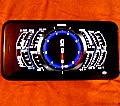 I was driving home from Virginia when I stopped for gas. I couldn't read the LCD display on the gas tank, and as a result I was likely not pressing the right buttons. Whatever the reason, I got so aggravated that I stomped into my car and drove away without buying gas there. Unfortunately my gas cap was still sitting on the trunk of the car, and I didn't realize it until I noticed cruise control wasn't working. It turns out that on a Subaru cruise control is disabled when your Check Engine light is on. And your Check Engine light comes on if you don't have a gas cap.
I was driving home from Virginia when I stopped for gas. I couldn't read the LCD display on the gas tank, and as a result I was likely not pressing the right buttons. Whatever the reason, I got so aggravated that I stomped into my car and drove away without buying gas there. Unfortunately my gas cap was still sitting on the trunk of the car, and I didn't realize it until I noticed cruise control wasn't working. It turns out that on a Subaru cruise control is disabled when your Check Engine light is on. And your Check Engine light comes on if you don't have a gas cap.
Subaru dealerships were closed on Sundays, so I went to an auto supply store and bought a third party gas cap. As it turns out replacing the cap will turn off the Check Engine light, but only after you have gotten gas a few times. I drove home without cruise control. About 20 miles from home the Check Engine light blinked off and cruise control worked again. By that time my leg was cramped, and I couldn't use cruise control anyway in downtown Ithaca.
If I had had an OBD-II (On-Board Diagnostic System) device that connects to my smart phone I could have reset the light myself. So I became obsessed with finding an affordable, reliable OBD-II device.
I am not a car guy. So I don't know why I am so fascinated with OBD-II. I guess the idea that my phone can talk to my car excites me for some reason. I was never a fan of 'My Mother The Car' or 'Knight Rider' so this obsession just came out of nowhere. Before I was done I ended up trying three different devices over a two year period before I finally found one I liked that is reliable. So this is the saga of my quest to find a good, usable OBD-II thingie that connects to an iPhone.
These devices are small dongles that plug into the OBD-II port in your car. This is the same receptacle that your mechanic plugs his diagnostic computer into when checking out your car. In most cars it is located under the dashboard, below the steering wheel, where you can't see it unless your head is on the floor. Instead of a big device like your mechanic has, the dongle is just a little plastic plug that can read the signals from your car's computer and broadcast them to your smart phone.
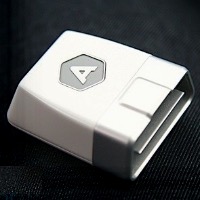 AutomaticThere didn't seem to be many choices a few years ago that worked with iPhones, so I settled on the Automatic. The company was clearly trying to make a sleekly designed gadget that would look at home in an Apple Store, and the packaging was almost as Appley as the dongle itself. It connects to an iPhone via Bluetooth, and you download its accompanying app for free from the Apple App Store.
AutomaticThere didn't seem to be many choices a few years ago that worked with iPhones, so I settled on the Automatic. The company was clearly trying to make a sleekly designed gadget that would look at home in an Apple Store, and the packaging was almost as Appley as the dongle itself. It connects to an iPhone via Bluetooth, and you download its accompanying app for free from the Apple App Store.
Automatic's hook is that it wants to make a better driver of you. From a technical standpoint it really works. It connects reliably, and a great feature of the app is that it creates maps of each trip you take. I didn't find that part 100% reliable, but good enough. And the engine light reset works well, and has understandable explanations of what caused the light to come on.
The problem I have is that it is so judgemental of my driving. I find it extremely annoying, like those Coke machines that actually talk to you. It beeps every time it thinks you are going or stopping too fast. It doesn't really know the speed limit, so if you are in a state with a fast speed limit that is higher than Automatic's idea of a fast speed limit, you are stuck with poor scores and warning beeps. Thank heavens you can at least turn off the beeps! But I don't like it when a back seat driver rides with me, and I certainly don't like it when that back seat driver is a gadget!
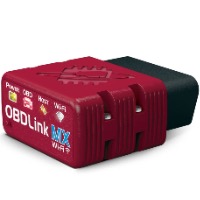 OBDLink WifiSo I got an OBDLink MX Wifi. This, as the name suggests, connects via wifi, not Bluetooth. Essentially it creates a hot spot attached to your car's computer and you connect to it with your phone. The good news: it is compatible with the best, in my opinion, OBD app, DashCommand. All these devices have their own apps, and the free app you get with this device is the best of the three I tried.
OBDLink WifiSo I got an OBDLink MX Wifi. This, as the name suggests, connects via wifi, not Bluetooth. Essentially it creates a hot spot attached to your car's computer and you connect to it with your phone. The good news: it is compatible with the best, in my opinion, OBD app, DashCommand. All these devices have their own apps, and the free app you get with this device is the best of the three I tried.
But DashCommand is graphically the best, literally turning your smart phone into a real-time dashboard. There are evidently hundreds of dashboard designs you can download. My favorite is the Lexus dashboard, mainly because I like its looks and layout. I have a Subaru, and don't really want a Lexus. Remember? I'm not a car guy. But this dashboard is pretty. And it's functional and uses MPH, not KPH, so I understand how fast I am really going.
The bad news is that I never know if it will connect to my phone, or stay connected. That can be a problem on a long trip, or even a short one, especially if you have a Check Engine light issue. I know, I am making it sound like my engine is on the verge of extinction. It's not, but it does hiccup from time to time. It would work for a few days, and then it wouldn't connect for love or money. I knew I was upgrading my phone, so I waited for the new one, and it was the same thing.
The OBDLink has little lights and modes you access with a little button for setting it up and such, which would be a lot more useful and exciting if the gadget weren't plugged in under the dashboard where you can't see it. What's the fun -- or use -- of little blinking lights if you can't see them? I suppose you could mount a mirror between your legs, but I doubt that is a recommended driving practice.
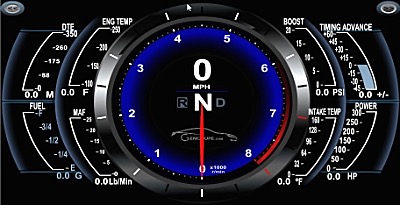
But the OBDLink wouldn't connect for love or money. So I plugged the Automatic back in. I hadn't used it in about a year so I had to reinstall it on the phone, not really a big deal once I realized I had to do it. Now I was able to reset the Check Engine light in about two seconds. I decided to keep using the Automatic because it connects reliably. But after about two minutes I became extremely irritated with its constant nagging about how fast I accelerate or decelerate. Bloody back seat driver!!!
So I researched again and got a GoPoint BT1.
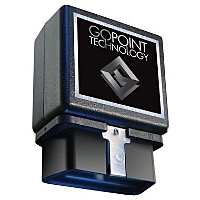 GoPoint BT1
GoPoint BT1 As far as I can tell, after having this thing for only a week or two, this is the OBD device for me. It's free app is the least able of the apps that go with the three gadgets. It is useful for setting up the BT1, though once you have Bluetooth set up there isn't anything else to do. But the BT1 is compatible with DashCommand, and it connects to the phone just fine every time. The BT1 app can reset the Check Engine light, but so can DashCommand. So there is actually no need to use the GoPoint app most of the time if you have decided to spring for the 9.95 DashCommand app (if you have an Android phone instead of an iPhone it appears to be free, at least on the day of this writing). This little thing is truly plug-and-play. I plugged it in, paired the Bluetooth to my phone, and it just started working.
If you pair all this with a holder for your phone, you end up with a little dashboard that is getting info from your car computer the same as your actual dashboard. It has added advantages of conveying much more detailed information than your actual dashboard offers, logging, and the ability to see those error codes and reset the Check Engine light -- which otherwise could cost you a $300 repair shop visit. In my first adventure with the Check Engine light that would have been one expensive gas cap!
At this stage in my saga I recommend the GoPoint BT1, which is compatible with both iPhone and Android phones. I really just want it to plug in and work and give me the data I want without back-seat driving. The BT1 does that.
v11i28




